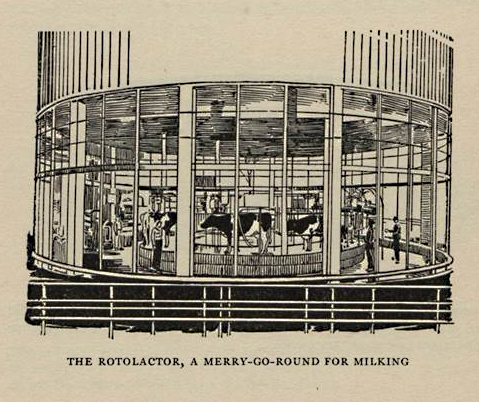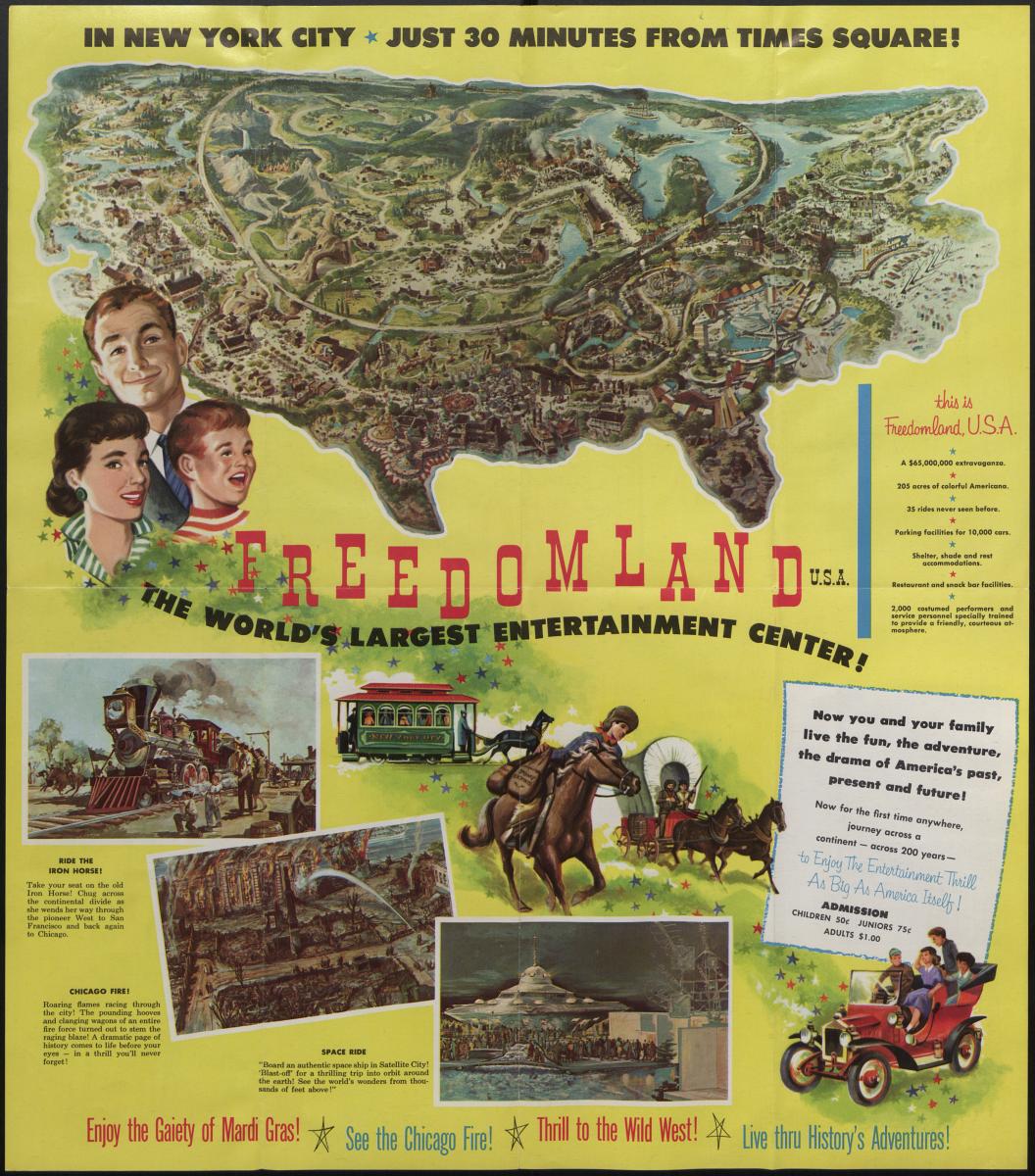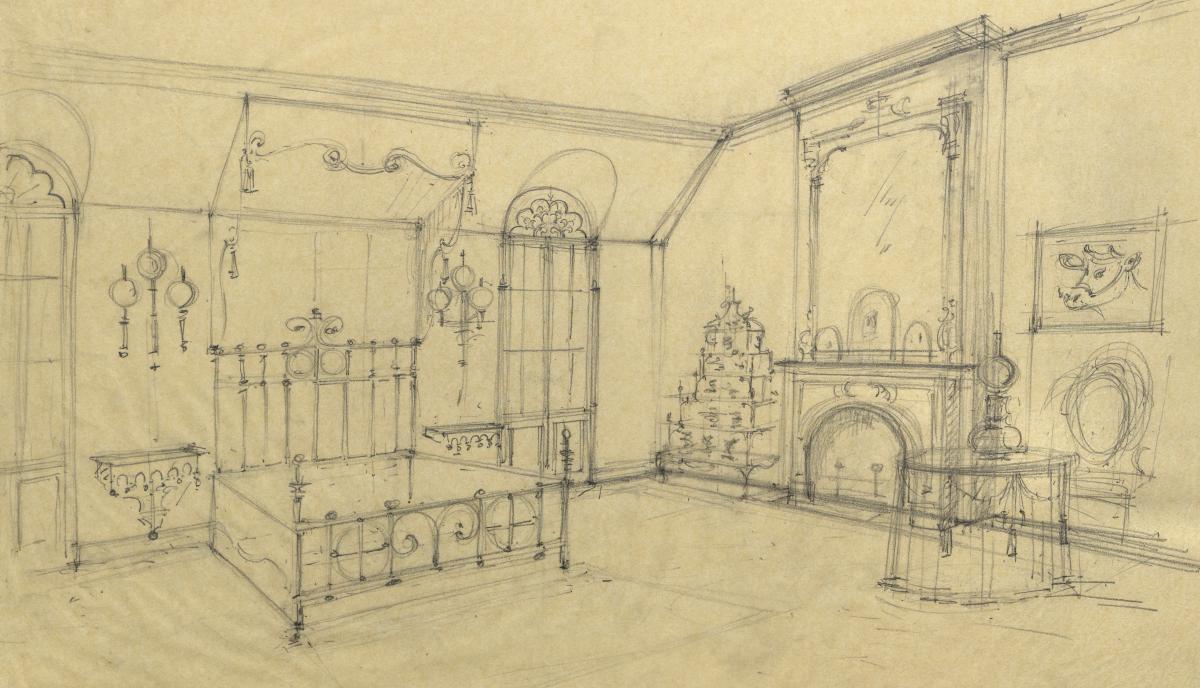 Standing in the intersection of the histories of interior design, agricultural technology, World's Fairs, American marketing, theme parks, and several Hagley collections, is a bright-eyed Jersey cow wearing a wreath of yellow daisies around her neck. Her name is Elsie. She is the spokes-cow for the Borden Company and, in 2000, Ad Age named her one of the Top 10 Advertising Icons of the Twentieth Century.
Standing in the intersection of the histories of interior design, agricultural technology, World's Fairs, American marketing, theme parks, and several Hagley collections, is a bright-eyed Jersey cow wearing a wreath of yellow daisies around her neck. Her name is Elsie. She is the spokes-cow for the Borden Company and, in 2000, Ad Age named her one of the Top 10 Advertising Icons of the Twentieth Century.
In the 1930s, the American dairy industry struggled amidst the Great Depression, which saw decreased consumer demand and production surpluses. Major milk companies, like Borden, clashed with small-scale dairy farmers in a highly publicized series of “milk strikes.” Seeking to battle this negative image, in 1936, Borden’s advertising department introduced Elsie in their print marketing. The move gave big agribusiness the face of a happy, friendly, maternal cow with a curiosity for modern technologies.

 After existing solely as a cartoon, Elsie became a real cow at the 1939 World's Fair in New York. The Borden Co. exhibit featured a state-of-the-art "merry-go-round for milking cows" called a Rotolactor. This machine automated the milking process and could milk 150 cows an hour (although the exhibit ignored the implication that such technological efficiency had contributed to the decade's milk surplus). Exhibit goers, however, were less interested in the technology and instead demanded to know which cow was Elsie. At this point, Borden plucked a seven-year-old Jersey named "You'll Do Lobella" from the obscurity of the herd to become the star attraction.
After existing solely as a cartoon, Elsie became a real cow at the 1939 World's Fair in New York. The Borden Co. exhibit featured a state-of-the-art "merry-go-round for milking cows" called a Rotolactor. This machine automated the milking process and could milk 150 cows an hour (although the exhibit ignored the implication that such technological efficiency had contributed to the decade's milk surplus). Exhibit goers, however, were less interested in the technology and instead demanded to know which cow was Elsie. At this point, Borden plucked a seven-year-old Jersey named "You'll Do Lobella" from the obscurity of the herd to become the star attraction.
For the second season of the fair, Borden added a "Barn Colonial Boudoir" so that Elsie could rest in comfort while greeting her admiring public. After the fair ended, Elsie travelled all over the country with her boudoir, while her cartoon doppelgänger smiled across Borden's national magazine advertising campaigns. A now ubiquitous symbol, she appeared in films, sold war bonds, wrote recipes, and even made a trip to outer space (in a promotional comic book found in Hagley's Library collection).
Whenever the real Elsie passed away, Borden quickly and quietly selected a new cow to assume the moniker. Over the years, Elsie's fictional family grew to include her "husband" Elmer (of Elmer's Glue fame), girl calf Beulah, bull calf Beauregard, and twin girl calves Lobelia and Larabee.
Eventually, Elsie caught the attention of the firm of Ernest Dichter, a pioneer in consumer motivational research whose collection is at Hagley. In 1949, the firm proposed a study on Elsie's ongoing effectiveness as a sales tool and mused on ways to modernize her image to sell more Borden products. Despite this proposal, Elsie proved to have staying power in the heart of the American consumer. Borden continued to use Elsie’s image throughout the 1950s even as they diversified beyond dairy products.
 In 1960, the real Elsie, still making public appearances, crossed paths with interior design legend William Pahlmann, whose extensive collection is at Hagley. Borden contacted Pahlmann's New York firm to design a new "Elsie's boudoir" as part of an attraction at the soon-to-open Freedomland U.S.A.
In 1960, the real Elsie, still making public appearances, crossed paths with interior design legend William Pahlmann, whose extensive collection is at Hagley. Borden contacted Pahlmann's New York firm to design a new "Elsie's boudoir" as part of an attraction at the soon-to-open Freedomland U.S.A.
Located in the Bronx, New York, promoters heralded the American history-themed Freedomland as the East-Coast's answer to Disneyland, which had opened five years previously. "A $65,000,000 extravaganza," Freedomland included seven sections based on American geography, 35 rides, and 2000 costumed performers and employees. In the Great Plains section, Borden sponsored a "Mid-West Farm,” which displayed "America's agricultural and dairy heritage” with farm animal exhibits and a barn tour.
William Pahlmann Associates cut no corners, given their most unusual client. While previous iterations of Elsie's boudoir leaned barnyard chic, Pahlmann's firm went full Victorian with their design. In their write-up about the design, Pahlmann Associates declared the boudoir would be in "Elsie's favorite colors—foliage and deep grass greens, strawberry red, clover white, buttercup gold, dandelion yellow and sky blue." Their design featured brass and crystal oil chandeliers, an oil portrait of a young Elmer, a rosewood bookshelf-magazine rack, and a costumer for displaying Elsie's hat collection. The focal point of the room was Elsie’s brass bed, which had a mother-of-pearl inlay on the headboard and canopy with a large “E” embroidered in gold. The bedroom also included a hexagonal playpen so Elsie could keep a close eye on her twin calves.

Thrilled with the design, the Borden representatives requested only one major change: adding a crossbar between Elsie and the brass footboard of the bed. Being a cow with a fondness for head scratches, the representatives worried that "if possible, she will rub her head with great vigor against any protrusions and bumps on the brass footboard."
 Pahlmann Associates completed the project in time for the amusement park’s opening in late June 1960. Despite the elegance of the accommodations, Elsie’s tenure at Freedomland, U.S.A. was short-lived. The entire venture struggled to recover its massive start-up costs and declared bankruptcy only four years after opening. Admirers of Elsie could still catch her nearby, though, at the 1964 New York World’s Fair, where she starred in a musical revue entitled “All About Elsie.” She later took a well-earned, decades-long sabbatical away from the advertising spotlight before reemerging in the 1990s.
Pahlmann Associates completed the project in time for the amusement park’s opening in late June 1960. Despite the elegance of the accommodations, Elsie’s tenure at Freedomland, U.S.A. was short-lived. The entire venture struggled to recover its massive start-up costs and declared bankruptcy only four years after opening. Admirers of Elsie could still catch her nearby, though, at the 1964 New York World’s Fair, where she starred in a musical revue entitled “All About Elsie.” She later took a well-earned, decades-long sabbatical away from the advertising spotlight before reemerging in the 1990s.
While she no longer holds the same level of stardom she once enjoyed, Elsie lives on today as the mascot for the current Borden Dairy brand.
Additional Resources
- Hajdik, Anna Thompson. “A ‘Bovine Glamour Girl’: Borden Milk, Elsie the Cow, and the Convergence of Technology, Animals, and Gender at the 1939 New York World’s Fair.” Agricultural History 88, no. 4 (2014): 470–90.
- Montague, Theodore G. 1939. Is There a Milk Monopoly? New York: Borden.
- New York Museum of Science and Industry. 1940. Exhibition Techniques; a Summary of Exhibition Practice, Based on Surveys Conducted at the New York and San Francisco World’s Fairs of 1939. New York: New York Museum of Science and industry.
- Time, Inc. 1965. 1965 Official Guide: New York World’s Fair. New York: Time, Inc.
- Tindall, Edward E, and C. Stanton Clark. 1998. Walker-Gordon : One of a Kind. Stockton, N.J: Covered Bridge Press.
- World's Fairs: A Global History of Expositions (available to onsite Hagley researchers and offsite database subscribers)
Angela Schad is the Head of Reference Services at Hagley Museum and Library
